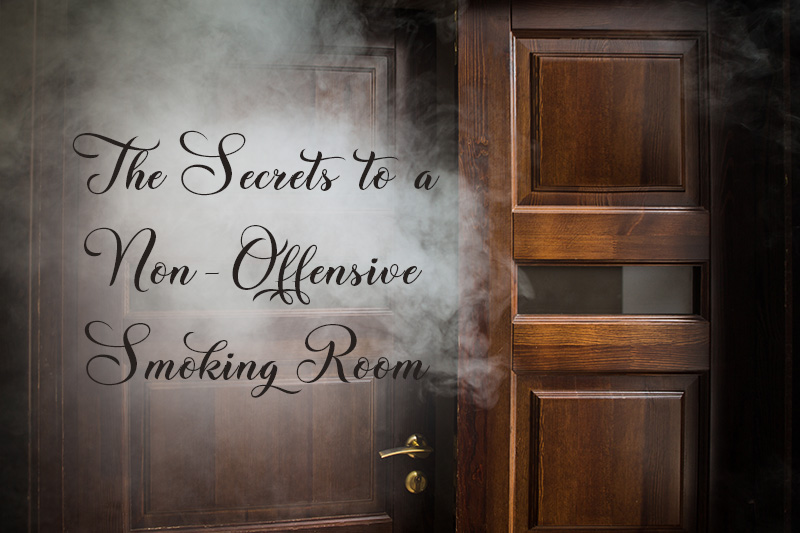The Secrets to a Non-Offensive Smoking Room

Because pipe and cigar smoking are accompanied by aromas that are underappreciated by the uninitiated and uncivilized, some of us restrict our smoking to the outdoors. The outdoors is great, but it isn't perfect. We sometimes deal with blizzards, floods, hurricanes, lightning, mosquitos, bears, pterodactyls — I had a friend named Levi Jenkins who stepped outside for a pipe one night and never returned. His wife swears he was carried off by a Sasquatch. She heard him call, "A dang Bigfoot snatched my pipe, Bessie, and I'm going after it!" The outdoors is unpredictable.
Sasquatch avoidance is why many of us have our own smoking rooms. A few of us smoke anywhere we like, but these days a specified room is often the best we can hope for. And if we're lucky enough to have that room, it serves an important function: to keep smoke out of the rest of the house. That means all the smoke has to stay in that room, and there are ways to do that. It also means that the room risks getting pretty rank, and there are ways to avoid that.
We enthusiasts are obviously unoffended by the smell of smoke. I like the aroma, but I am probably nose-blind to much of it. We get used to it. I don't smell tobacco in my clothes or hair, but I know it's there because others have occasionally commented, like cashiers wondering out loud who is smoking in the store.
It's also appropriate to restrict the geography of smoke in our homes if we're likely to want to sell that home. I smoked throughout our house in Raleigh, NC, and when we were ready to move, we replaced all the carpets, scrubbed every surface, and repainted walls, ceilings, and window frames. Still, some potential buyers detected tobacco with their bloodhound-like senses and were, therefore, uninterested. If we restrict our smoking to a single room and are successful in keeping any smoke from escaping, there is less work to do when it's time to move.
Insulation For Your Smoking Room
The first and only real line of defense for a smoking room is the door. A tight seal is our friend, and there are two aspects to consider: the floor gap and the door frame seal.
Smoke is an escape artist. Without precautions, it will seep from under and around the door of your smoking room. It wants out so it can agitate your spouse, cause potential discontent about your smoking, and insinuate its way into the rest of the home to exasperate visiting anti-tobacco relatives.
Door sweeps are easily installed devices that close the gap between the bottom of the door and the floor, resting directly on the floor and providing a good seal. Their primary use is as weather insulation, but they work well with smoke as well. They're replaceable when they wear out but will last for years. Some are in a brush form, made of fibers, and some are rubber. As long as they touch the floor, they both work fine. I've used both, and though it seems intuitive that the brush variety would be less effective, I've noticed no difference in performance.
They are common products available at hardware stores, Walmart, Amazon, or wherever you shop, and they're inexpensive, especially when considering how well they work.
Without precautions, it will seep from under and around the door of your smoking room.
Smoke may also escape around the door's perimeter, and simple weather stripping will help with that. It, too, is available everywhere and comes in various forms. It's better to employ a rubber type rather than foam because foam can more readily absorb smoke odors.
Now that we've ensured that the smoke will stay inside our smoking rooms, there are other issues to be resolved. Smoke will insinuate its way into every drawer and crevice and adhere to every surface, and where it settles, it leaves an odor.
For example, I have two plaster busts of Mark Twain. Yes: two. I know what you're thinking: How is life fair when this guy has two busts of Mark Twain, and I don't even have one? It's a story of intrigue and mayhem, but I believe the fault lies not with me but with you, dear reader. It is beyond comprehension that some people pursue their daily lives with only one Mark Twain bust or even less.
They are replicas of the busts given to guests at Mark Twain's 70th birthday celebration in 1905, and I keep one in the living room, where I don't smoke, and one in my home office, where I always smoke. They were purchased at the same time. Can you tell which is which?

The office version has darkened like a meerschaum pipe because of the never-ending smoke. The smoke residue is absorbed not only by Mark Twain but every other surface in my office. It's happening in your smoking room, too. I like the smoke-colored Twain better, so I don't clean it, but I clean everything else. It's a nice color. I think I could attain the same deep tan if I gave up showering, but my wife would probably be opinionated about that and she already has opinions enough to keep her occupied.
Smoke will insinuate its way into every drawer and crevice
Smoke molecules travel in microscopic globules of oil and moisture, going wherever air can go. Walls, ceilings, pictures, windows, lamps, and everything else will discolor and begin to smell like stale tobacco over time, and don't let me get started on what it does to ceiling fans. Books, too. Paper absorbs tobacco smoke with remarkable efficiency, and I'm afraid all my books are goners. I brought one to work and opened it for a non-smoking colleague; they passed out and required paramedic-administered oxygen.
Baking soda is helpful, but in my experience, it is not a complete solution. Baking soda absorbs odors. The method employs a large plastic trash bag with a half cup to a cup of baking soda inside. Seal the offending books inside with it, preferably open and only a few at a time, leaving them overnight. It's a help but not a cure. As far as I know, there's no reasonably economical way to fully fumigate books — the pages may as well be tobacco leaves. But walls and other room surfaces have hope.
Cleaning Solutions

A number of different products will remove smoke residue. White vinegar is an excellent solvent, but it smells like, well, vinegar. That smell will fade quickly, however. For use in a spray bottle, add just a few drops of vinegar to water at first, and increase the ratio if the stain requires more convincing. The same method can be used with a bucket of water, gradually adding more vinegar until the appropriate strength for the solution is found. Scrub at the wall or ceiling with a sponge in circular motions, then apply clean water with a wet towel and dry. You may have to repeat this procedure if the staining is particularly stubborn.
Another cleaning solution employs dish soap, baking soda, and water. Combine a gallon of water, three tablespoons of soap, and half a cup of baking soda. Apply as previously, being sure to wash the surface afterward with clean water and then dry it with a clean towel.
Walls, ceilings, pictures, windows, lamps, and everything else will discolor and begin to smell like stale tobacco over time,
Perhaps the easiest cleaning method is with Mr. Clean's Magic Eraser. It's an all-purpose cleaner that works well with tobacco stains and residue. Simply wet the scrubber and start scrubbing.
For tougher stains, mix a half cup of ammonia with a gallon of water. Ammonia is pretty pungent and corrosive, so use gloves and make sure the area is well-ventilated. You might consider a mask as well — you don't want to breathe much ammonia.
Another chemical to consider is trisodium phosphate, one tablespoon per gallon of water. Trisodium phosphate was once found in many household cleaners, but it is uncommon now because when it makes its way into the water table, it depletes oxygen levels in lakes and rivers. This method is for only the most stubborn stains and requires the use of goggles, a mask, and rubber gloves.
Walls and Ceilings
Cleaning walls and ceilings is a pain, but if you implement the process annually, it will keep your room smelling fresh. Always test any solution, applying it to a small portion of the surface beforehand to be sure no discoloration or damage to drywall occurs. That corner behind the chair would be a good test spot.
Start with the ceiling. Smoke rises, after all; the ceiling is particularly exposed, and if you splash the walls, you'll follow up on those areas next. You'll need a large sponge, a bucket for cleaning solution and another for fresh water, a few towels, and perhaps a spray bottle if you prefer application that way.
Combine a gallon of water, three tablespoons of soap, and half a cup of baking soda.
Soak a towel or rag in the cleaner and scrub in small sections. Scrub again with a clean wet cloth, and then dry with a clean dry cloth.
Fabrics
Baking soda also helps remove odors from fabrics and carpets. It's probably better to avoid fabrics in a smoking room, as it's easier to clean smoke film from leather and wood than from fabrics. But if you do have upholstery and carpeting, sprinkle baking soda over them, wait overnight, and vacuum thoroughly to remove the odor.
Glass
Windows and picture glass respond well to Windex and other glass cleaners, and the cleaning solutions mentioned previously will also work. If you go a few months between cleanings, you may be distressed to see how much residue has accumulated. It will inspire you to clean more often. There are increments of contamination, of course — I am an extreme case, and your mileage may vary.
Remember to clean all surfaces, including electrical cords, window sills, the wall clock, air conditioning grates, picture frames, and furniture. Everything in that room is subject to a layer of residue. And don't forget the ceiling fan blades; the leading edges will require particular attention.
When your room is clean, there are everyday habits that can help keep it that way.
Daily Precautions
Be sure to empty ashtrays every day, or several times a day, depending on your consumption. Don't let ashes sit out overnight; the odor will permeate the environment.
If you go a few months between cleanings, you may be distressed to see how much residue has accumulated.
Pipe cleaners are essential maintenance tools for pipe smokers, but they shouldn't be left in an ashtray after use because they, too, smell bad. I can't smell them unless I hold one under my nose, a recreation I rarely entertain, but nonsmokers can detect them from a distance. Cleaners can't be simply tossed into an open wastebasket. It's best to utilize a lidded waste can so the odor of ashes and pipe cleaners is contained. I've been using a lidded waste can for several years now and am amazed at how bad it can smell when I open it. All of that smell would be in my room without it.
Pipes will smell like tobacco — there's no way around that. Swabbing out the bowl with a doubled-over pipe cleaner after every use helps keep that to a minimum, but if you're trying to keep their odor under control, a pipe cabinet with doors may work better than open-air pipe racks.
Air Cleaning and Circulation

A window fan set to exhaust works wonders to recirculate the air and expel smoke. The downside is that you're blowing heated or cooled air into the outdoors, and that adds to the expense.
Air purifiers clean the air without cooling or heating the neighborhood, but they can be expensive, loud, and disappointing. I've tried many over the years but currently employ a window fan because I've been displeased with purifiers. The ones that have worked relatively well have been as loud as lawnmowers and too distracting for me to use regularly.
I've been browsing for another, though, hoping that more recent technology may have caught up with my needs. There is one that I'm considering: the RabbitAir A3 Ultra Quiet Air Purifier. It has some great reviews that insist it works even with multiple cigar smokers. It's expensive, though: $750, and the replacement filters are expensive too. It would be a terrible disappointment if it didn't work for me. But it seems to be the best available now for smokers, and I may eventually decide to try yet another purifier in my office. If you're looking for such a device, you might start by checking out the reviews for the A3. I have no affiliation with the product; it just seems to have the best reviews that I've found so far. If you use this one or another that seems to work for you, I'd appreciate learning more in the comments section.
It's best to utilize a lidded waste can so the odor of ashes and pipe cleaners is contained.
Something that does work for me and is silent is a scented candle. I've purchased a considerable number of the Smoke Odor Exterminator candles we carry here at Smokingpipes. They work well and smell great, and my wife likes them a lot. We also carry Lampe Berger lamps and oils, and I've heard good things about them but have no personal experience. I've been happy with the candles so far. If you have experience and would be willing to share, I'd like to hear about it, and I'm sure our readers would too.
Most of us are probably okay with the way our smoking rooms smell. We like the smell of tobacco. Many of us revel in it. But we make accommodations for family, guests, and perhaps future homeowners. Some of these methods require time and effort, but they have been proven to work. It's up to you to what extent you might employ them. Good luck with your quest, and in terms of your smoking room's scent, may the compliments be many and the complaints few.











Comments
I appreciate the ideas. Smoking in apartments while not tipping off neighbors management has become a hobby of mine. I'm planning on getting some tubing and in-line fans for the apartment, and directing it outside. Smoking outside in the Midwest is restricted to half the year, so I'm going to try all of your suggestions. Take care.
"Air Cleaning and Circulation"I use a cheap (eBay) dehumidifier with the silica gel dumped out, and reloaded with activated charcoal. Change the charcoal monthly.
My smoking room is an outdoor three season room which is warm enough to smoke in for easily 7 to 8 months of the year. Even that room, with all its windows open, retains a smoke odor.
This is for you Chuck. I purchased the Rabbit Air Minus A2 for my office, and it works great. My office was a small bedroom I converted downstairs. I am going to look into weather stripping the door though. Depending on the size of your office of corse, will determine which Rabbit Air to go with.
My wife smokes cigarettes so the more my pipe stinks the better the house smells.
I only smoke at my desk which is in a room without a door- it is open to the rest of the house. My wife sits on the other side of the Partners Desk. I have a HEPA air filter on top of my forced air heating system where the return air duct connects. The is HEPA filter is good for a year or two on constant air flow. The thermostat allows me to just turn on the fan, which I do when I am smoking. The return air duct is at ceiling level 10 feet from my desk. This really works.
Much practical advice here, but owning three cats and a big hairy dog and having always loved the smell of pipes and cigars as well as being a long-time consumer of tobacco (for over 60 years--I'm into my eighties now), I am more moved by your writing for its entertainment value and 19th century style of humor than its 21st century technical content. Not only do you possess two busts of Samuel Clemons, but your "voice" is a reincarnation of Mark Twain himself. Thank you!
This post provides an insightful and practical guide for maintaining a pleasant smoking room. Your detailed advice on managing smoke and odor, from sealing doors to cleaning surfaces and utilizing air purifiers, demonstrates a deep understanding of the challenges faced by enthusiasts. Your humor and personal anecdotes make the recommendations both engaging and relatable, offering valuable tips for anyone looking to create a more enjoyable smoking environment.